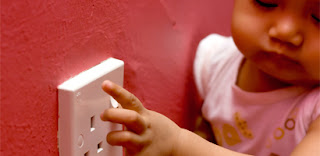Home is a special place when you are growing up. It’s a place to explore, to have adventures and to play. The home is also the most common place for young children to be injured. Most accidents are predictable and preventable. Try to make the home environment as safe as possible before your baby arrives and again before your child starts crawling. You must always ensure the inside of your home is safe. You must also consider hazards found in outdoor areas, particularly the driveway, front and rear gardens, pool and barbeque areas, garden sheds, play areas and cubby houses.
One of the best ways to reduce the risk of injury is to make some physical changes to the house. Look at your home and think about what the obvious risks and hazards are. Remove the risk or hazard, if possible, or add a safety product to minimize the chance of injury. For example, if you have a low table with sharp corners, you can attach corner covers or you can simply remove and temporarily store the table elsewhere.
Before considering what safety products you need, remember you can always change the layout of a room to help create a safer environment. If you are building or renovating your house, you can incorporate specific safety features in your design. The time to start making some changes or additions is well before
your baby begins to crawl.
Door and stove barriers
Use a door barrier or a safety gate to keep a young child out of the kitchen, particularly at busy times such as when dinner is being prepared. A safety gate/barrier will allow children to play safely in an adjacent room, but still enables you to see what’s happening on the other side.
Locks and safety catches
There are many dangerous chemicals and cleaning products kept in the kitchen, laundry and medicine cabinet. Ensure these are put away immediately after use and stored in a locked or out-of-reach cupboard greater than 1.5 meters high.
Other safety products
There are many more safety products available for purchase:
- Safety tap caps – are designed to prevent children from turning on a hot tap which results in household hot water burns and can be easily installed without the assistance of a plumber or handyman.
- Finger protection strips – are an innovative yet simple design to prevent children from trapping their fingers between the door and door hinge.
- Power point covers – prevent electrocution from open power sockets by covering the point and preventing objects being poked into them.
- Doorknob covers – make it difficult for children to open a door and prevent them from entering a room.
- Blind cord windups – can help prevent strangulation by ensuring long cords are not left dangling.
- Foam door stoppers – help protect little fingers from being jammed in doors.
Other safety tips
- Keep plastic bags and deflated or burst balloons away from young children.
- Use plastic inserts to cover electric outlet openings that are not being used.
- Keep alcohol and cigarettes out of reach.
- Keep guns and other firearms out of the house. If guns are in the house, unload them, put them in a locked place and keep the keys out of your child's reach. Store the gun in a separate place from the bullets.
- When your baby is placed on anything above the ground, like a changing table, always stand close with your hand on your baby.
- Lock matches and lighters in a cabinet that is higher than your shoulders.
Your Baby's First Year: Week by Week
You might also like
More Baby Care Topics
Hepatitis B Vaccine
MMR Vaccine
BCG Vaccine
Polio Vaccine
HIB Vaccine
Typhoid Vaccine
Rota Virus Vaccine
Baby Care: Useful TipsMMR Vaccine
BCG Vaccine
Polio Vaccine
HIB Vaccine
Typhoid Vaccine
Rota Virus Vaccine
Ideal weight gain in a New Born Baby
How much sleep does your baby need?
Breast Feeding Techniques
Well Breast Feeding Signs
Bottle Feeding Advantages
How do I store my Breast Milk?
Which day care center is more comfort?
















0 comments:
Post a Comment